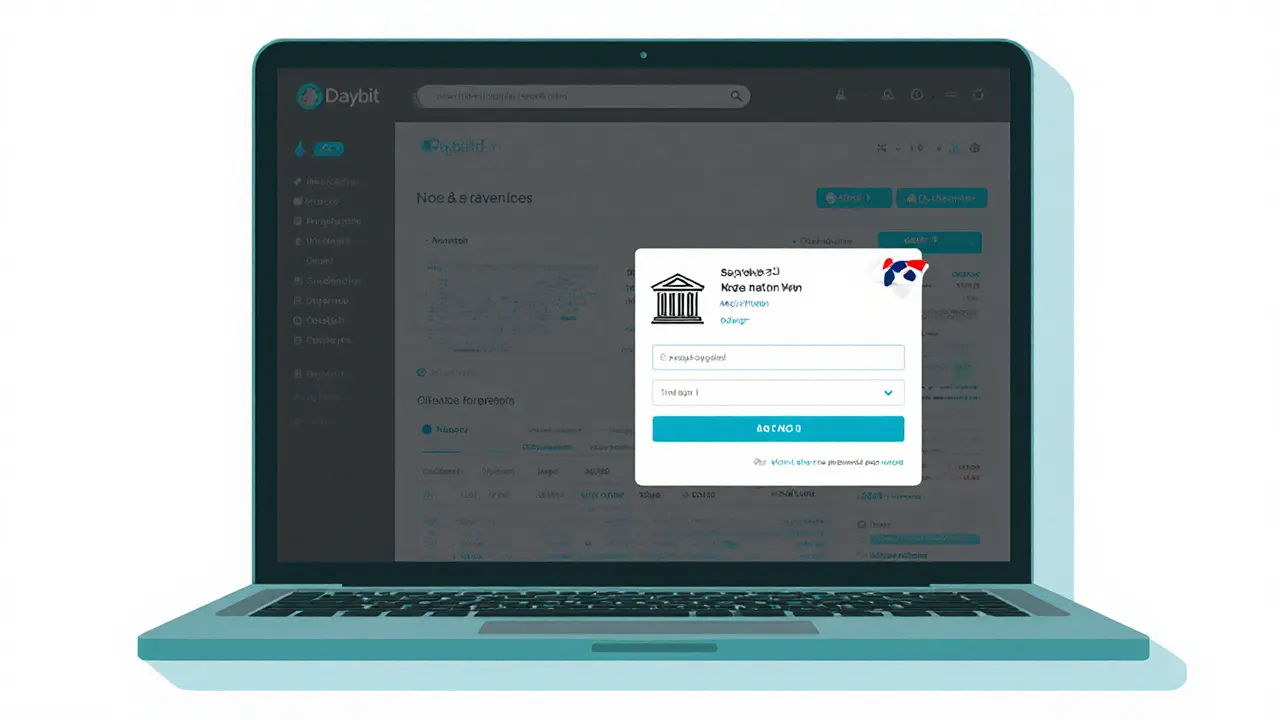Oct 24, 2025, Posted by: Ronan Caverly

Daybit Exchange Fee Calculator
Daybit Exchange
Taker Fee: 0.15%
Fiat: KRW only
Features: Spot trading only
Binance (Competitor)
Taker Fee: 0.08%
Fiat: Multiple options
Features: Spot, Futures, Staking, etc.
Important Note: Daybit only supports KRW deposits. This calculator compares the trading fee structure only. Always consider all aspects of an exchange before depositing funds.
Daybit Fee
$0.00
Binance Fee
$0.00
Difference
$0.00
Daybit fees are 100% higher than Binance.
Based on information from the article: Daybit charges 0.15% taker fee versus Binance's 0.08% fee.
If you’re scanning the web for a Daybit Exchange review, you’ve probably noticed how little information is out there. That’s because Daybit Exchange is a fringe platform with almost no visibility on the major market data sites that most traders rely on. In this article we’ll break down everything you can actually verify - the fees, the fiat options, the security posture, and how it stacks up against the big players.
What Is Daybit Exchange?
Daybit Exchange is a little‑known cryptocurrency trading platform that primarily accepts Korean Won (KRW) deposits. The service emerged sometime before 2024, but it never gained traction on the major aggregators. On CoinMarketCap it is listed as an “Untracked Listing,” meaning there is no publicly reported volume, order‑book depth, or reserve data. In plain English: the market can’t see how much is being traded, which makes risk assessment tougher.
How Daybit Handles Deposits and Withdrawals
The platform only supports fiat deposits in Korean Won (KRW). There is no credit‑card gateway, no PayPal, and no support for other major currencies like USD, EUR, or GBP. Users must have a Korean bank account or a way to move KRW into the exchange’s local accounts. Withdrawal works the same way - you can only pull crypto assets back to an external wallet; fiat withdrawals are limited to KRW transfers to a Korean bank.
Trading Fees Compared to the Industry
According to Cryptowisser, Daybit’s taker fee sits around 0.15%, which is noticeably higher than the 0.08%‑0.10% range most mid‑size exchanges charge. For reference, Binance offers 0.08% for spot trades, Bybit pushes it down to 0.03% for makers, and KuCoin often runs 0.03%‑0.07% promotions. The higher fee structure on Daybit makes it an unattractive choice for high‑frequency traders or anyone moving sizable balances.
Feature Set - What You Get (and What You Don’t)
Daybit’s UI is bare‑bones. It provides basic spot trading for a handful of major coins (BTC, ETH, USDT) but lacks the advanced charting tools, futures contracts, staking options, NFT marketplaces, or copy‑trading services that have become standard on larger platforms. There is also no mobile app listed on the Apple App Store or Google Play, meaning you’re stuck with the web client.
Security and Transparency
Because the exchange is untracked, there is no publicly audited proof of reserves. The website does not publish a security audit, cold‑storage ratio, or any details about multi‑sig setups. No major security firm has issued a review, and there are no known incidents, but the absence of evidence is itself a red flag. Compare that to Binance, which publishes quarterly security reports, or Bybit, which has undergone third‑party audits.
Community and Support
One of the biggest tell‑tale signs of a healthy exchange is an active community. Daybit has virtually no presence on Reddit, no Trustpilot page, and no dedicated Telegram or Discord channels that show regular engagement. Customer support is only reachable via a generic email form, with response times that users on other forums have described as “slow” or “non‑existent”. By contrast, platforms like Bitpanda maintain multilingual help centers, live chat, and active social media accounts.
Comparison Table: Daybit vs. The Big Players
| Feature | Daybit Exchange | Binance | Bybit | KuCoin |
|---|---|---|---|---|
| Trading Fees (taker) | 0.15% | 0.08% | 0.03% | 0.05% |
| Fiat Support | KRW only | USD, EUR, GBP, KRW, many more | USD, EUR, USDT, KRW | USD, EUR, GBP, KRW, many more |
| Advanced Products | Spot only | Spot, Futures, Options, Staking, Savings | Spot, Futures, Perpetuals, Copy‑trade | Spot, Futures, Staking, Lending |
| Liquidity (24‑h avg.) | Untracked / negligible | >$30 B+ | $8 B+ | $4 B+ |
| Mobile App | No official app | iOS & Android | iOS & Android | iOS & Android |
| Security Audits | None disclosed | Quarterly third‑party audits | Annual audits, bug bounty | Regular audits, bug bounty |

Is Daybit Worth Using?
Putting the pieces together, the platform looks like a niche service aimed at Korean traders who need a simple KRW‑to‑crypto gateway and don’t care about advanced features. If you already have a Korean bank account, are comfortable with higher fees, and don’t need futures or staking, Daybit could serve as a straightforward entry point. However, for anyone outside Korea, or anyone with any need for depth, security transparency, or a vibrant community, the trade‑offs are steep.
Potential Confusion with DayBit.com
Do not mix up Daybit Exchange with DayBit.com. The latter is a separate website that curates crypto‑exchange reviews and promotes gambling‑related services. Its branding is similar, but its business model is completely different. When you search for “Daybit,” make sure the URL you land on ends with “exchange” rather than “.com” to avoid ending up on a review portal instead of the actual trading platform.
How to Stay Safe When Trying a Low‑Profile Exchange
- Start with a tiny deposit - no more than a few hundred dollars worth of crypto.
- Withdraw the funds to a personal wallet as soon as you can test the withdrawal process.
- Keep an eye on community forums; if the platform disappears, you’ll want to know before you’ve put too much money inside.
- Consider using a hardware wallet for any assets you plan to hold long‑term.
Bottom Line
Daybit Exchange offers a minimalistic, KRW‑centric trading experience with higher fees and almost no public data. It trails behind Binance, Bybit, and KuCoin in every measurable category - fees, liquidity, security, and feature set. If you’re based in South Korea and need a quick KRW‑to‑BTC bridge, it might get the job done. For everyone else, the smarter move is to stick with a well‑known exchange that provides transparent reporting, lower costs, and a richer toolbox.
Is Daybit Exchange safe to use?
Safety is hard to verify because Daybit does not publish audit reports or proof‑of‑reserves. The lack of transparent security information makes it riskier than exchanges that undergo regular third‑party audits.
What fees does Daybit charge for spot trading?
Daybit’s taker fee is about 0.15%, which is higher than the 0.08%‑0.10% range you’ll find on most mid‑size exchanges.
Can I fund Daybit with a credit card?
No. The platform only accepts Korean Won deposits via local bank transfers. Credit‑card, PayPal, or other fiat methods are not supported.
How does Daybit compare to Binance?
Binance offers lower fees (0.08%), dozens of fiat options, a massive liquidity pool, and a full suite of products like futures, staking, and a mobile app. Daybit only supports KRW deposits, has higher fees, and provides spot trading for a few major coins.
Is there a Daybit mobile app?
No official iOS or Android app is listed. Users have to rely on the web interface, which limits accessibility on the go.
What are the risks of using an untracked exchange?
Without public volume data, you can’t gauge liquidity, making large orders vulnerable to slippage. The lack of audit reports also means you can’t confirm how the exchange secures user funds, increasing the chance of loss if something goes wrong.
Write a comment
Comments
Richard Williams
Sounds like solid advice for anyone testing a new exchange.
October 24, 2025 AT 09:52
Elizabeth Mitchell
The review does a good job laying out the basics.
It’s clear that Daybit’s fee structure is on the higher side.
The lack of fiat options beyond KRW really limits its appeal outside Korea.
Security transparency is another weak point, especially with no proof‑of‑reserves.
For users who just need a simple KRW gateway, it might still make sense.
November 1, 2025 AT 23:22
Edwin Davis
Indeed, the fee disparity is glaring!!!, and the KRW‑only limit restricts global access,, which is a significant drawback,,.
November 10, 2025 AT 12:52
emma bullivant
I think the piece captures the essence, but there are some minor errors like “saftey” instead of “safety”.
The overall tone is helpful though, and the table makes comparison easy.

Author
Ronan Caverly
I'm a blockchain analyst and market strategist bridging crypto and equities. I research protocols, decode tokenomics, and track exchange flows to spot risk and opportunity. I invest privately and advise fintech teams on go-to-market and compliance-aware growth. I also publish weekly insights to help retail and funds navigate digital asset cycles.